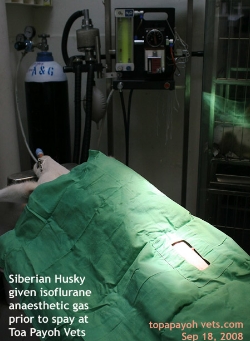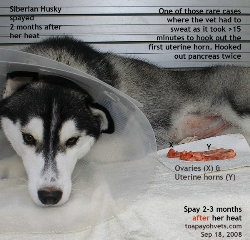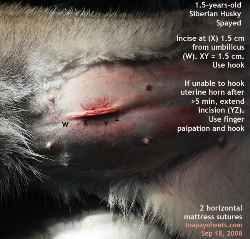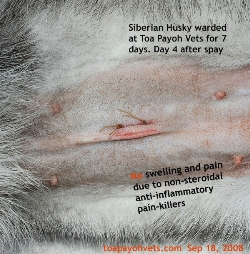|
SOLUTIONS
SPAY TIPS FOR RECENT VETERINARY GRADUATES
 Many
female dogs spayed by using a hook to fish out the womb and
ovaries. You would have thought that the bigger the dog, the
easier it is to spay her. Many
female dogs spayed by using a hook to fish out the womb and
ovaries. You would have thought that the bigger the dog, the
easier it is to spay her.
In this
Siberian Husky, I was not able to hook out the womb for more
than 15 minutes. Spaying for the past 20 years and yet I still
encounter such situations.
I hooked standing from the one side of the table. Unsuccessful.
Went to the other side of the table. No luck. "Is this female
dog normal? the thought crossed my mind. Has she got the wombs
developed normally?
I hooked up the pancreas
twice - firm, creamy white glistening lobulated tissues of
around 5 x 3 cm.
In so many spays, I had never hooked the pancreatic tissues in
so many spays. This dog had not been spayed
before as she was a puppy with the owner. She had her first heat
2 months ago.
So she should have her reproductive organs. So, what was the
problem? What would be the solution?
Many seconds ticked by. I
extended the incision caudally by 0.5 cm so that my gloved
forefinger just entered the abdomen to search and feel for the uterine
horn.
I swept the finger up and down, back and forth. There were intestines
and nothing felt like the uterine horns.
Short of extending the incision more to look for the uterine horn, I
tried the hook again.
Many owners appreciate a short skin incision and therefore it would be
best to use the hook rather than cut more.
I got the uterine horn this time
and managed to complete the spay. The surgery normally takes 20
minutes but this one took twice the time.
The uterine horn was bigger than
normal. Well, this was an unusual case and life is always full of
surprises. |

In such apparently "hopeless" situations, it is best to
extend the incisions to see the uterine horns,
especially for recent veterinary graduates.
Forget about the "hook" method and the beauty of a short
skin incision.
Complete the surgery in as short a time as possible as the
risk of dying from anaesthesia will be lowered if you
don't take too long to do the spay.
A healthy female dog can take the anaesthesia for over 2
hours, but why take the risk? |
 A
long incision will heal at the same rate as a short incision. So,
don't try to hook when you can't find the uterine horns after 15
minutes. A
long incision will heal at the same rate as a short incision. So,
don't try to hook when you can't find the uterine horns after 15
minutes. |
 A
non-steroidal anti-inflammatory injection given to this Siberian Husky
was effective in preventing licking and permitting the wound to heal
very well. A
non-steroidal anti-inflammatory injection given to this Siberian Husky
was effective in preventing licking and permitting the wound to heal
very well. |
Once in a while, any vet would
encounter such situations where the hook fails to do its job. A poor
workman blames his tools?
Well, it is not so easy to analyse and say why the hook failed to do
its job. Mother Nature seems to throw some challenges to get a vet out
of complacency during spay with many peculiar challenges enough to
cause baldness in many male vets.
It could be the positioning of the dog, the stretching of the
body with strings, the height of the operating table. I don't really
know but such situations do occur one in a hundred spays I do. The
hook just failed to do the job. In such situations, extend the
incisions and let the owner think poorly of your technique rather than
keep on hooking. Every second the dog is anaesthesized, the risk of
dying on the operating table is increased, especially for dogs in poor
health, especially those over 8 years old!
Don't take risk. Complete the spay in the shortest possible time
without the hook. |
|